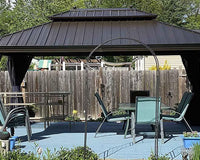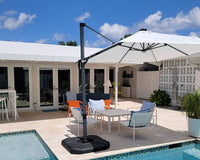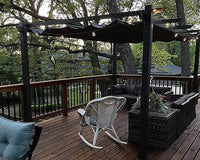As the colder months approach, many homeowners wonder if they can still enjoy their outdoor living spaces. The answer lies in selecting the right type of gazebo that can withstand the challenges of winter weather. Using a well-designed, winter-suitable gazebo can transform your backyard into a year-round oasis, providing a cozy and protected environment for entertaining, relaxation, or simply enjoying the beauty of the season. Knowing the features and considerations for winter gazebos, you can extend the use of your outdoor living space and make the most of your investment, even when the temperatures drop.
What Types of Gazebos Are Suitable for Winter Conditions?
There are several types of gazebos specifically designed to withstand the challenges of winter weather.
| Gazebo Type | Key Features |
| Hard-Top Permanent Gazebos |
- Metal (aluminum or steel) frame construction - Polycarbonate or insulated roofing materials - Weather-resistant design - Requires secure foundation for installation |
| Heavy-Duty Fabric Gazebos |
- Reinforced frames to handle snow loads and wind - Snow-load-rated canopy fabrics - Removable or convertible designs for seasonal adaptability - Durable, weather-resistant materials |
| Enclosed Gazebo Models |
- Glass or acrylic panel walls, which can be fixed or sliding - Removable/retractable walls for customizable enclosure - Insulation options for improved temperature control - Ventilation considerations for indoor-outdoor flow |

What Are the Essential Features Required in a Gazebo for Winter Use?
When choosing a gazebo for use in the winter months, there are several essential features to consider to ensure it can withstand the challenges of the colder season.
Structural Requirements
- The gazebo's frame and roof must be designed to support the weight of accumulated snow, which can be substantial in some regions.
- The structure should be able to withstand strong winter winds without compromising its stability or integrity.
- A secure, level foundation is crucial to providing a stable base for the gazebo, especially in areas with freeze-thaw cycles or heavy snowfall.
- The support beams must be sturdy enough to bear the increased weight and stress of winter conditions.

Weather Protection Elements
- The gazebo's roof should be made of waterproof and weather-resistant materials to prevent leaks and protect the interior space.
- Effective drainage systems, such as gutters and downspouts, are necessary to prevent water buildup and minimize the risk of dams.
- The roof should be shaped or angled to facilitate the natural shedding of snow, reducing the accumulation on the structure.
- The materials used should offer UV protection to prevent fading and deterioration of the gazebo's components over time.
Winterization Features
- Incorporating heating elements, such as electric or propane heaters, can extend the usability of the gazebo throughout the colder months.
- Proper insulation, either in the roof, walls, or both, can help maintain a comfortable temperature inside the gazebo.
- Sealing any gaps or openings in the structure can help prevent drafts and improve the overall energy efficiency.
- Ventilation systems and dehumidifiers can help manage condensation and moisture buildup, which can be a common issue in enclosed winter gazebos.
How to Maintain and Care Gazebo in Winter
Before the winter season arrives, carefully inspect the structure, addressing any issues and reinforcing it as needed to enhance snow load and wind resistance. Weatherproof the gazebo by sealing gaps, applying sealants, and verifying the integrity of the roof and walls. Conduct safety checks to ensure secure anchoring and proper electrical function.
During winter, regular maintenance is key. Promptly remove snow from the roof, manage ice formation, and conduct periodic inspections. Remain vigilant for signs of distress and be prepared to take emergency action if necessary.

How Much Does a Winter-Proof Gazebo Cost?
The cost of a winter-proof gazebo can vary significantly but generally ranges from $3,000 to $15,000 or more, depending on the specific features and quality of the materials.
Initial Investment
Material quality is a significant consideration, as higher-grade materials like metal frames and insulated roofing tend to cost more than basic models. For example, a steel-framed gazebo with a polycarbonate roof can cost 20–30% more than an aluminum-framed model with a standard fabric canopy. However, the sturdier steel construction and insulated roof can provide better protection and energy efficiency in the long run.

Larger or more elaborate gazebo designs naturally require a higher investment. Additionally, any customization or additional features, such as built-in heating systems or specialized snow-shedding roof designs, can add to the overall cost. The complexity of the installation process, including any necessary foundation work, can also contribute to the initial investment.
Long-term Value
By ensuring the gazebo can withstand severe winter conditions for 10-15 years or more, durable, weather-resistant materials like powder-coated steel frames and tempered glass panels help to lower the need for frequent replacements or significant repairs. When compared to less expensive devices that would need replacements every five to seven years, this can be a major cost reduction.
Thanks to insulation and temperature control mechanisms, improved energy efficiency can also translate over time into reduced heating and cooling expenditures. For instance, compared to an uninsulated, unheated construction, an insulated gazebo including built-in electric heaters can save homeowners up to 30% on their energy expenditures. Moreover, the inclusion of a useful and pleasing outdoor living area can improve the whole worth of your house, thereby maybe raising its resale value by 5-10% or more.
Potential Challenges and Solutions for Winter Gazebos
Winter gazebos can bring special challenges that need careful thought and preparation, even if they provide the chance to enlarge your outdoor living area.
Snow Accumulation
Too much snow on a roof could damage the structural integrity of the gazebo, causing sagging, collapse, or failure.
- Solution: Make sure the gazebo's reinforced support and sharply pitched roof can manage large snow loads. To help snow shed, include heating elements or snow guards.

Ice Formation
With slick surfaces and icicle formation, icy conditions can cause dangers both inside and outside the gazebo.
- Solution: To control ice accumulation on the construction, use anti-slip surfaces, set heated wires, and apply de-icing agents.
Moisture and Condensation
The combination of warm, enclosed spaces and cold outdoor temperatures can lead to condensation, which can damage surfaces and promote mold growth.
- Solution: Implement proper ventilation, use dehumidifiers, and choose water-resistant materials.
Drafts and Heat Loss
Uncontrolled air movement and inadequate insulation can result in drafts, reduced thermal efficiency, and significant heat loss.
- Solution: Seal gaps, install weatherstripping, and incorporate insulation in the walls, roof, and floor. Add removable or retractable side panels to create a more enclosed and climate-controlled environment.




